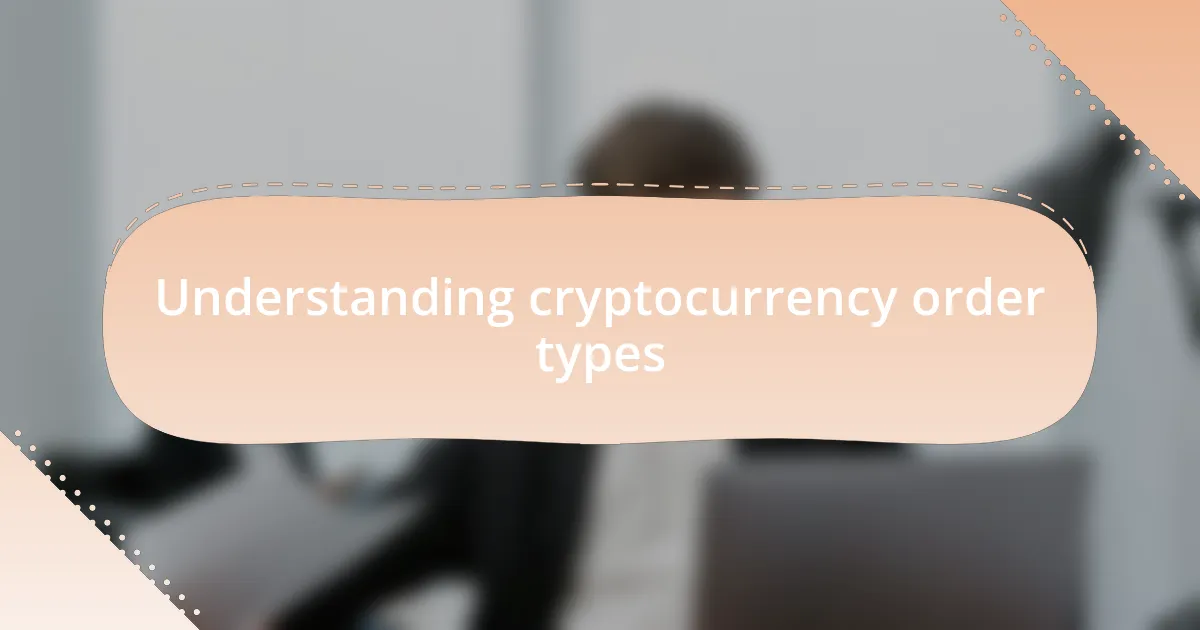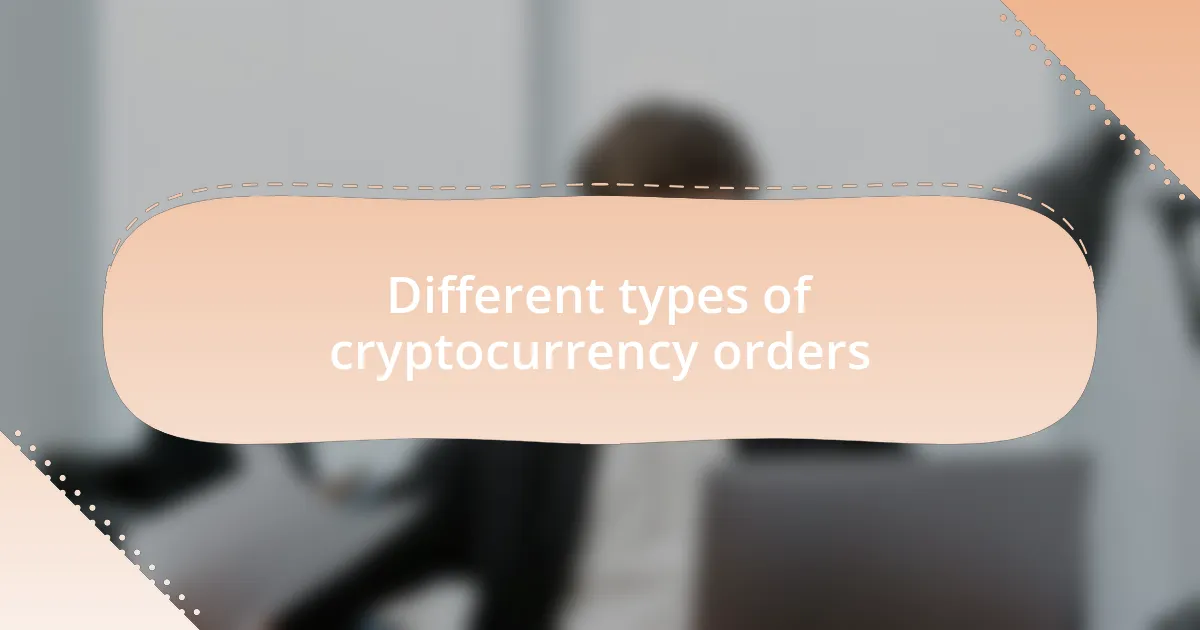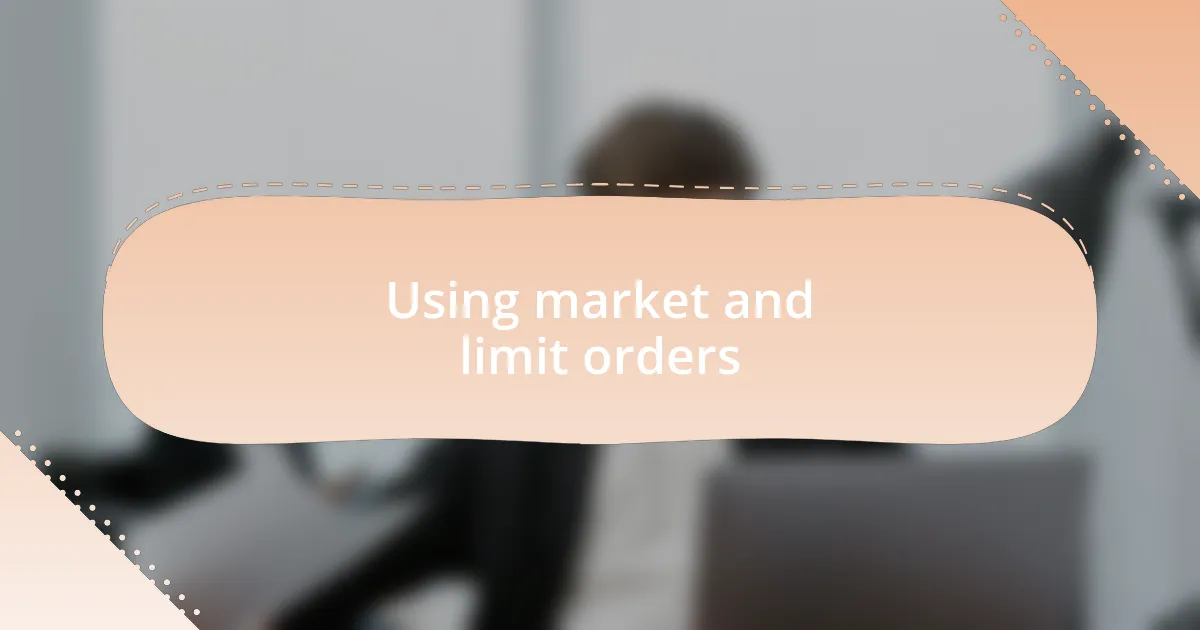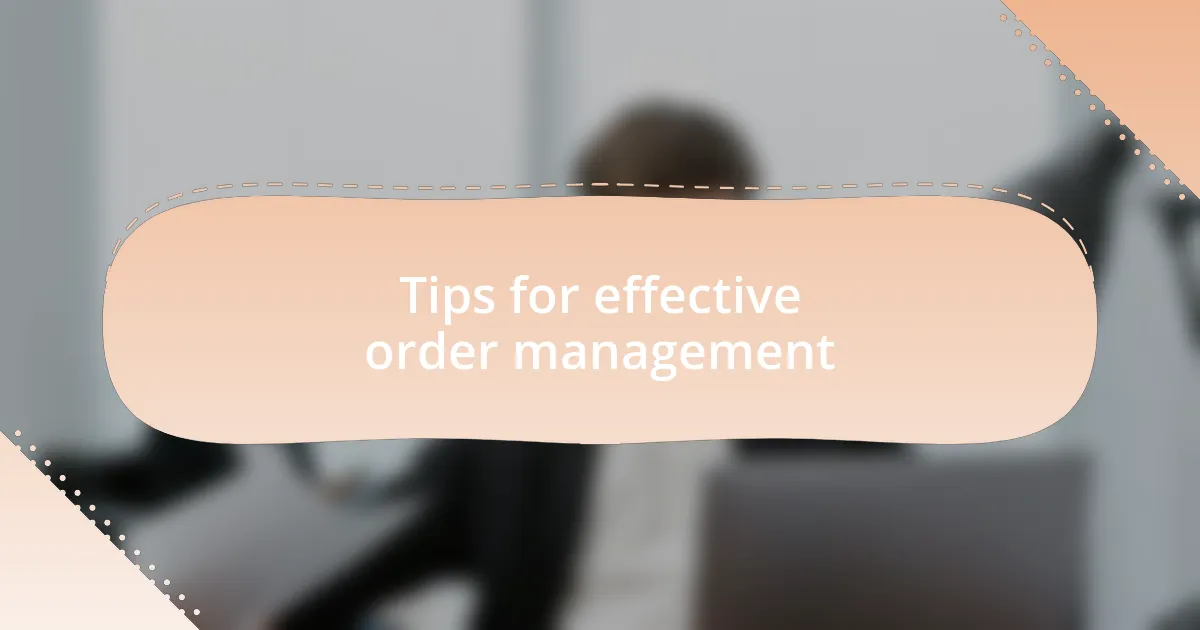Key takeaways:
- Understanding different order types (market, limit, stop, stop-limit, and trailing stop) is essential for effective trading and managing risks.
- Setting clear entry and exit strategies can significantly reduce trading stress and enhance decision-making.
- Monitoring market conditions and exercising patience are crucial for navigating volatility and making informed trading choices.
- Each order type impacts a trader’s psychology, emphasizing the balance between instinct and strategy in the decision-making process.

Understanding cryptocurrency order types
When diving into cryptocurrency trading, understanding order types is essential for executing trades effectively. I remember my first experience trying to place an order; it felt overwhelming with all the options presented to me. I quickly realized that knowing when to use a market order versus a limit order could make a significant difference in my trading outcomes.
Market orders allow you to buy or sell immediately at the current market price, which is great for swift trades, especially during volatile market swings. However, I once made the mistake of placing a market order during a sharp downturn without fully grasping the impact, and let me tell you, that was a wake-up call! Have you ever felt the anxiety of watching your investment fluctuate drastically right after an order? It’s moments like these that reinforce the importance of understanding the tools at our disposal.
On the other hand, limit orders offer more control over the price at which you buy or sell, which can be particularly useful in a fluctuating market. I’ve found that when I’m patient and set a limit order, it often feels more strategic, almost like fishing for the right catch rather than just casting my line blindly. Isn’t it empowering to know that with the right understanding, you can ride the waves of the crypto market with greater confidence?

Different types of cryptocurrency orders
When it comes to cryptocurrency orders, there are a few more types worth knowing about beyond just market and limit orders. Take stop orders, for instance. I remember using a stop-loss order for the first time; it was like a safety net for my investments. This type of order automatically sells your cryptocurrency when it reaches a certain price, helping to limit potential losses. Have you ever set a strategy to prevent emotional decisions during market drops?
Another order type that caught my attention is the stop-limit order. This combines elements of both stop and limit orders, allowing for even more precision. I once used a stop-limit order to sell when the price dipped, but I set my limit just above my stop price to ensure I wouldn’t be left holding the bag during a sudden spike. The experience taught me the value of planning ahead and cemented my belief that the right order type can help you execute your trading strategy with finesse.
Lastly, there’s the trailing stop order, which is particularly fascinating to me. It lets you lock in profits while still allowing for upward price movement. I recall when I used a trailing stop on a winning trade, and watching it rise felt exhilarating. Yet, I knew that this order type could also be a double-edged sword; if the market turns, it could just as easily trigger a sell. Have you considered how using different order types can completely transform your trading journey?

Using market and limit orders
When I first started trading cryptocurrencies, understanding the difference between market and limit orders was crucial. Market orders, which execute trades instantly at the current market price, felt like a rush. I remember a time when the price of Bitcoin was rapidly climbing, and I wanted to jump in right away. That adrenaline rush, typing “buy” without hesitation, was unmatched. However, the aftermath taught me about the importance of timing.
Limit orders, on the other hand, allowed me to set the exact price I was willing to pay for a cryptocurrency, giving me a bit more control. I vividly recall a day when Ethereum dipped unexpectedly. Instead of blindly buying, I set a limit order to purchase only at a price I found favorable. I felt a sense of empowerment seeing my order get filled, proving that patience can be rewarding. Have you ever held back on a market impulse, trusting your strategy instead?
Ultimately, navigating between these two types of orders has shaped my trading approach. The immediate satisfaction of market orders can be enticing, but the strategic foresight of limit orders offers a safety net for my portfolio. I often ponder, how often do traders lean towards instinct over strategy? Balancing these approaches has been essential in crafting a thoughtful trading journey.

Personal experience with order types
As I continued my trading journey, I discovered the nuances of stop orders. I still remember the day I set my first stop-loss order. The market felt unpredictable, and I was anxious about a sudden downturn. By implementing that stop order, I felt a wave of relief; it was as if I had built a safety net that allowed me to step back and breathe.
Another memorable experience was when I experimented with take-profit orders. I had a target price in mind for a trade on Litecoin. Watching the price inch closer to my predetermined level was exhilarating, but I also felt a weight of anticipation. The moment my take-profit order executed, it was a mix of joy and validation—knowing that planning and discipline had paid off. Isn’t it fascinating how these different order types can lead to vastly different emotional experiences during trading?
I’ve come to appreciate how each order type can significantly impact a trader’s psychology. Balancing the fear of missing out with a strategic approach often feels like walking a tightrope. There are days when instincts push me toward quick trades, while other times, I find solace in a methodical approach. How do you navigate the emotional rollercoaster of trading?

Tips for effective order management
When it comes to effective order management, I’ve learned that setting clear goals is absolutely essential. Early in my trading experience, I remember launching into trades without defining my exit strategies, which often led to stress and second-guessing. It was a valuable wake-up call when I realized that knowing my entry and exit points beforehand could really take the pressure off. Have you set your trading goals yet?
Another key aspect is the importance of monitoring market conditions frequently. There have been times when I got too comfortable with a stable market, only to face sudden volatility that wrecked my plans. Staying informed allows me to adjust my orders proactively, which can mean the difference between a mild setback and a full-blown disaster. How often do you check in with the market trends?
Lastly, I can’t emphasize enough the value of patience. I vividly recall a situation when I was eager to jump at a seemingly perfect entry point but decided to wait for confirmation instead. That decision paid off as the market shifted in my favor just moments later. It’s a reminder that sometimes, slow and steady truly wins the race in the world of trading. How do you practice patience in your trading strategy?